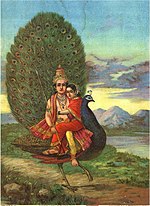Kavadi Aattam
| Part of a series on |
| Hinduism |
|---|
 |
| Part of the series on |
| Kaumaram |
|---|
 |
Kavadi Aattam (
History
In
Murugan had previously been outwitted in a contest for going round the world where his brother Vinayakar won the jñāna paḻam, the fruit of wisdom. In anger and frustration, he left Mount Kailash and came down to Tiru Avinankudi, the foot of the Sivagiri Hill. His divine parents Shiva and Parvati tried to pacify him but Murugan withdrew to the hill and settled there as a recluse in peace and solitude.[4]
Idumban prayed to Murugan that whoever carried on the kavadi on their shoulders signifying the two hills and visited the temple on a vow should be blessed and that he be given the privilege of standing sentinel at the entrance to the hill. This custom of kavadi aattam has spread from Palani to other Murugan shrines worldwide.
Practice

The preparations start 48 days before the two-day Thaipusam festival. The devotees purge themselves of all mental and physical impurities. They take only one vegetarian meal per day and 24 hours before Thaipusam, they must maintain a complete fast.[2] The devotees prepare themselves by following strict purification austerities that include transcendence of desire, shaving of the head, following a vegetarian diet and refraining from alcohol, sexual abstinence, bathing daily in cold water, sleeping on the floor and constant prayer.[1]
On the day of the festival, devotees undertake a pilgrimage along a set route while engaging in various acts of devotion, notably carrying various types of kavadi (burdens). A kavadi consists of two semicircular pieces of wood or steel which are bent and attached to a cross structure that can be balanced on the shoulders of the devotee. It is often decorated with flowers and peacock feathers (the mount of Murugan) among other things. Some of the kavadi can weigh up to 30 kg.[2]
At its simplest, a kavadi may entail carrying a pot of milk (pal kavadi), but piercing the skin, tongue or cheeks with vel skewers is also common. The most spectacular practice is the vel kavadi, essentially a portable altar up to two meters tall, decorated with peacock feathers and attached to the devotee through multiple vels pierced into the skin on the chest and back. Fire walking and flagellation may also be practiced. It is claimed that devotees are able to enter a trance to overcome pain.[2]
Locations
Thaipusam is celebrated by the Tamils in India and other countries like Sri Lanka, Malaysia, Fiji, Mauritius, Singapore, Canada, United States, United Kingdom, Germany, France, Italy, South Africa and Indonesia.[5][6][7]
See also
References
- ^ ISBN 8791114896.
- ^ a b c d Hume, Lynne. Portals.
- ISBN 9789812307408.
- ISBN 978-981-4786-66-9.
- ^ "Thaipusam 2020". Sri Murugan Society Alberta. 14 February 2020. Retrieved 10 August 2022.
- ^ V, Nirupama (5 February 2019). "Concord Temple Yatra: Unique Feat". Best Indian American Magazine, San Jose. Retrieved 10 August 2022.
- ^ "Temple committee: Over 1,000 volunteers to assist Batu Caves temple ensure SOP compliance during Thaipusam". Malay Mail. 13 January 2022. Retrieved 10 August 2022.
